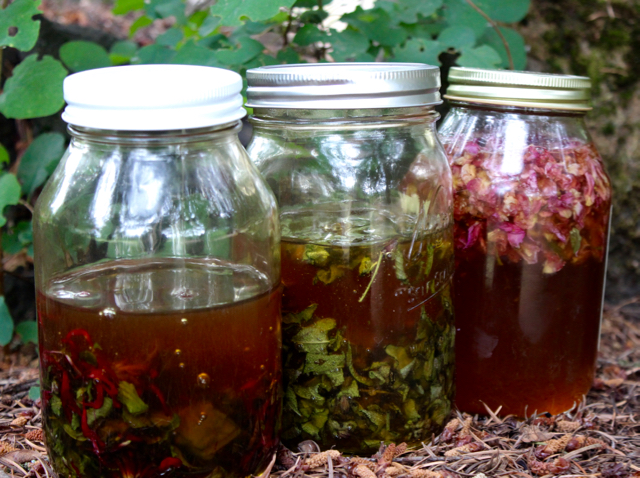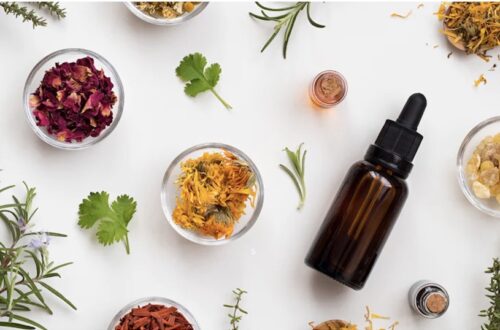“Herbal medicine provides relief while also assisting our immune systems do their jobs.”
Herbs offer us many gifts: culinary seasonings, teas, and nutritive medicine. Even though we are nearing the end of the growing season, there is still time to harvest and preserve herbs for use throughout the winter months. Be sure to dry herbs for culinary use and for teas, store them in glass jars to protect their aromatic oils. In this article, I describe a favorite way to preserve medicinal herbs for winter use.
Upper respiratory viruses are the most common ailments during the colder months, and we are most vulnerable during the seasonal transitions of fall to winter and winter to spring. We spend more time inside, and in close quarters with more people. Our immune systems take a hit as we indulge in less-than-healthy foods and habits. Viruses are shared and one cold morning, we may wake with a tender, inflamed throat, perhaps a fever and cough.
One of the challenges of local medicine is its availability when you need it most. This is why over-the-counter (OTC) medicine is so popular – it’s easily available. As discussed in earlier articles, most OTC products are designed to only suppress symptoms. Herbal medicine provides relief while also assisting our immune systems to do their jobs. Some planning and effort now will pay off later when you feel the crud coming on.
While Mary Poppins recommended “a spoonful of sugar to make the medicine go down”, we now know that cane sugar should be avoided whether sick or healthy. Herb-infused honeys easily replace sugar and offer medicinal qualities from both herbs and honey.
The Benefits of Honey
Honey is rich in antioxidants and loaded with phytonutrients. It promotes the growth of healthy bacteria in our intestines, supports digestion, and helps with sleep. It reduces coughing and produces a soothing and moistening effect on inflamed throats. Because of its ability to create hydrogen peroxide, honey is also considered anti-bacterial and anti-fungal. In fact, honey is used in topical dressings for burn victims. Unlike cane sugar, honey does not cause sugar spikes because of its healthy glycemic load. And amazingly, honey never goes bad.
But these benefits only apply to raw honey, which is usually produced by local beekeepers. The honey found in most grocery stores is pasteurized (which destroys much of its properties) and is usually imported from another country. A recent investigation found that grocery store honey is often adulterated with corn syrup and other unhealthy additives. You will find raw honey at farmers’ markets and stores that sell healthy foods. Support your local beekeepers and invest in a gallon of raw honey. Replace your use of unhealthy white sugar with wholesome honey.
The FDA does caution against giving honey to children under the age of one because honey can carry botulism spores. Research shows that 1.5 teaspoon of honey reduces coughing in children. This is important because medical experts warn against giving OTC products to children under the age of six.
Making Infused Honeys
Supplies:
• Raw (unpasteurized) honey – Minimum of one quart
• Glass jars – pints are perfect for small families but if you want to share some of your honeys then use quart jars
• Chopstick & silicone spatula
• Freshly cut herbs are preferred but dry herbs can be used
Directions:
1. Some herbs hold a lot of moisture in their leaves. Allow them to wilt a bit for 8-24 hours to remove some of the water. Honey is hygroscopic which means it absorbs moisture.
2. Remove stems and roughly chop herbs. Both leaves and flowers can be used.
3. Loosely fill the jar almost full with fresh herbs. (If using dried herbs, fill half full)
4. Fill the jar with honey, completely covering the herbs. Warming the honey slightly in a double boiler speeds up this step, but be sure to only warm and not cook or boil the honey.
5. Stir with a chopstick to remove air bubbles.
6. Cover with a tight-fitting lid and label the jar.
7. Place in a sunny windowsill for a week. The herbs will move
to the top so I like to turn the jars upside down each day to move the herbs through the honey. After a week, move the honey to your counter and allow it to steep for a few more weeks.
8. Some herbs will color the honey, and some will thin the honey. Infused honeys can be used to sweeten and flavor cereals, teas, salad dressings, baked goods, savory sauces, marinades, as well as fruits and vegetables.
Herbs
Lavender (Lavendula spp.)– Drizzle on ice cream, pound cake, scones, and biscotti. Lavender can produce a calming effect.
Lemon Balm (Melissa officinalis) – Delicious in both savory and sweet dishes and my personal favorite for sweetening tea. Lemon balm is soothing to the digestive and nervous system and aids in healing cold sores.
Sage (Salvia officinalis)– A must-have for the winter months! Sage’s anti-bacterial, anti-viral and anti-fungal properties have a long history of use for inflamed throats and helps with drying mucous.
Ginger (Zingibar officinale) Avoid using ground ginger; peel & chop fresh organic ginger. The moisture in the rhizome creates more of a ginger syrup. I make small batches and store them in the fridge. It’s a great remedy for upset stomachs and nausea. It also produces a warming sensation in the body.
Bee Balm (Monarda spp.) – Another potent medicine for the cold and flu season, bee balm offers a spicy, slightly sweet, taste. The flowers and leaves are anti-microbial and are well-suited to treat sore and inflamed throats. Like ginger, it also produces a warming sensation in the body.
Are you inspired? Look around your herb garden and in your spice cabinet for more ideas using mint, cinnamon (sticks or chips), anise star, vanilla, rosemary, thyme, chamomile, basil…
Then share your bounty with friends and family – herb-infused honey makes a unique but appreciated gift.
Sue Kusch tends to herb and vegetable gardens in the Columbia River Gorge and writes her blog Sleepy Hollow Homestead
Photo courtesy of Sue Kusch






